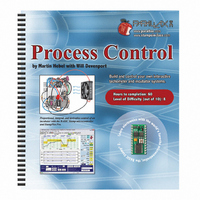122-28176 Parallax Inc, 122-28176 Datasheet - Page 88

122-28176
Manufacturer Part Number
122-28176
Description
GUIDE STUDENT PROCESS CONTROL
Manufacturer
Parallax Inc
Specifications of 122-28176
Accessory Type
Manual
Product
Microcontroller Accessories
Lead Free Status / RoHS Status
Contains lead / RoHS non-compliant
For Use With/related Products
Propeller Education (PE) Kit
Lead Free Status / RoHS Status
Lead free / RoHS Compliant, Contains lead / RoHS non-compliant
- Current page: 88 of 330
- Download datasheet (11Mb)
Challenge 3-7: Wiring a Relay
The relay can use high voltage, AC or DC, to energize a solenoid that closes or opens
electrically isolated mechanical contacts that can be used as input to the BASIC Stamp.
Signal conditioning these contacts is similar to the use of pull-up or pull-down resistors.
CONCLUSION
When acting as inputs, the BASIC Stamp typically senses a digital HIGH value for any
voltage above approximately 1.4 V and a digital LOW below 1.4 V. An input to the
BASIC Stamp does not necessarily need to be 5 V or 0 V, but must at least cross this
threshold voltage. Input voltages above 6 V will damage the BASIC Stamp.
BASIC Stamp inputs are uncommitted. That is, they are neither HIGH nor LOW without
an input committing them to the positive voltage or down to ground respectively. Most
mechanical switches require a pull-up or pull-down resistor for an Active-Low or Active-
High configuration respectively. Mechanical and electronic switches often require proper
conditioning.
Bipolar Junction Transistors (BJT) are current controlled devices that can operate as
current amplifiers or electronic switches. The base current controls the current in the
collector. With no base current, the transistor will be cutoff and act as an open switch.
With sufficient base current, the transistor's collector current will be at saturation, and the
transistor will act as a closed switch. The saturation current is a function of the supply
√
Wire the contacts (by drawing) in Figure 3-20 so the BASIC Stamp senses a
HIGH when S1 is closed, which energizes the solenoid and magnetically opens
the normally closed relay contacts labeled K1.
Figure 3-24
Sensing 115 V with a
Relay
(Drawing to be
completed by
student – do not
build)
Related parts for 122-28176
Image
Part Number
Description
Manufacturer
Datasheet
Request
R

Part Number:
Description:
MANUAL FOR SUMOBOT
Manufacturer:
Parallax Inc
Datasheet:

Part Number:
Description:
GUIDE STUDENT SMART SENSORS
Manufacturer:
Parallax Inc
Datasheet:

Part Number:
Description:
MANUAL PROPELLER
Manufacturer:
Parallax Inc
Datasheet:

Part Number:
Description:
LEAD WIRES FLYING CABLE III/IV
Manufacturer:
Xilinx Inc
Datasheet:

Part Number:
Description:
BOARD ADAPTER AND FLY LEADS
Manufacturer:
Xilinx Inc
Datasheet:

Part Number:
Description:
PLATFORM CABLE USB II
Manufacturer:
Xilinx Inc
Datasheet:

Part Number:
Description:
KIT STARTER COOLRUNNER-II BUNDLE
Manufacturer:
Xilinx Inc
Datasheet:

Part Number:
Description:
Microcontroller Modules & Accessories DISCONTINUED BY PARALLAX
Manufacturer:
Parallax Inc

Part Number:
Description:
Microcontroller Modules & Accessories DISCONTINUED BY PARALLAX
Manufacturer:
Parallax Inc

Part Number:
Description:
BOOK UNDERSTANDING SIGNALS
Manufacturer:
Parallax Inc
Datasheet:

Part Number:
Description:
BOARD EXPERIMENT+LCD NX-1000
Manufacturer:
Parallax Inc
Datasheet:

Part Number:
Description:
IC MCU 2K FLASH 50MHZ SO-18
Manufacturer:
Parallax Inc
Datasheet:












